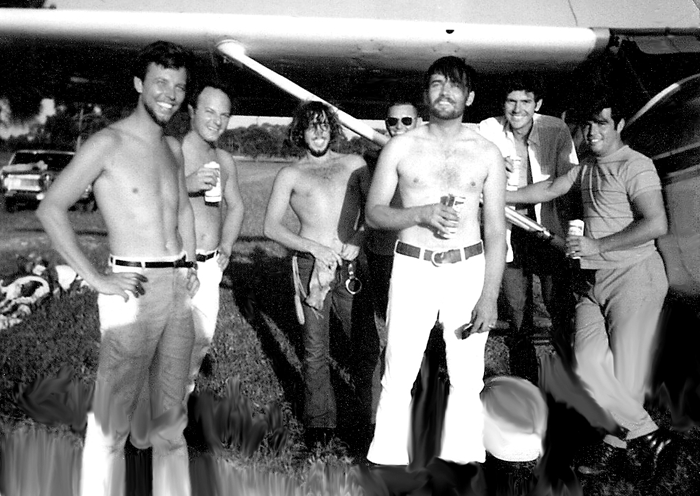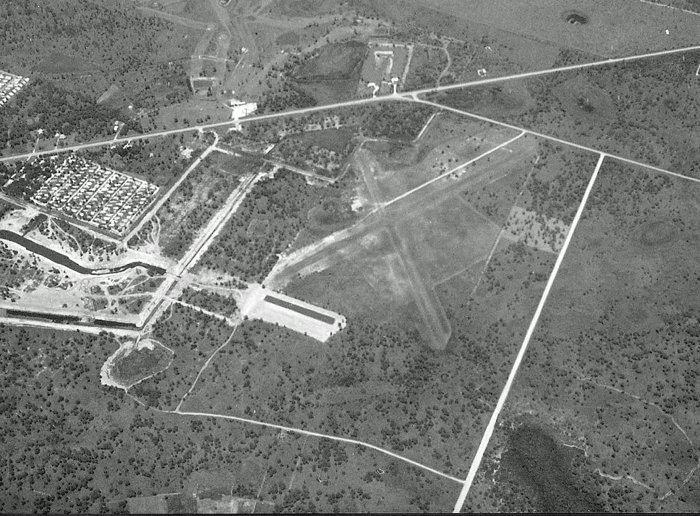Englewood
MY FIRST NIGHT JUMP
Mike Swain, USPA #387, D-2078
Jump: 213
Date: March 2, 1968 (Started skydiving March 22, 1964)
Location: Buchan Airfield, Englewood, Florida
Aircraft: Cessna 172
Altitude: 7,500 feet
Equipment: Para-Commander main, unmodified 24 foot Twill reserve with no pilot chute
Buchan airfield in Englewood, Florida south of Sarasota was the site of my first night jump. It was March 2, 1968 and unusually cold for Florida. I had been skydiving all that day at Pop Poppenhager’s drop zone in Indiantown on the east coast of Florida. I packed my chute fast after my last jump and had come roaring across the state in my ’66 Corvette to arrive just in time to take part in our first ever night jumps. Duffy Nathan, the leader of our group, the Mission Valley Skydivers, sent a few of the newer jumpers out to gather dead wood from the nearby trees that surrounded the small airport and we soon had a roaring bonfire burning. There was supposed to be a full moon for our night jumps, but a high solid overcast had turned the night into an ink pot.
Like something out of a James Dean movie, we positioned our cars with headlights on to help delinate the field for our pilot to land. Even so, he had a difficult time and declared that he wouldn’t be landing there after the first jump. The next loads would have to drive north to Venice where the airport had lighted runways.
The first load of three jumpers suited up; Stan Stanton, Billy Revis, and myself. Except for altimeter lights taped on top of our front-mounted reserves, none of us were really properly prepared with proper lights for relative work at night. So instead of atempting anything fancy, we were just going to get out of the plane one at a time at 7,500 feet and space ourselves out for thirty seconds of freefall alone.
Before boarding the plane, on the spur of the moment, I stuffed a flashlight and a flare unceremoniously into the front of my jumpsuit. Without a door on the plane, the climb to altitude was freezing cold but seemed to be over way too soon. Stan was the first to exit with Billy soon to follow. I got positioned in the door and counted slowly to five before I rolled out of the plane. The blackness swallowed me up. There was nothing to do and nothing to see, so I just fell and watched my altimeter. At 2,500 feet, I pulled my ripcord and got a very gentle opening. Much too gentle; something wasn’t right. I unzipped the top of my jumpsuit, got out my flashlight, and tentatively shined it up into my canopy.
In the glow of my flashlight, I could see that the left half of my Para-Commander was wadded up in a ball, entangled with some lines. Even as I looked, the turn accelerated into a full-fledged spin. I saw that there would be no way to clear it. Oh, hell! My first night jump and I was going to have to cut away and open my reserve.
At that time, we had only the standard World War II "Capewell" releases attaching both parachute risers to the harness. These were heavy-duty metal connectors which were activated in two stages using both hands in coordination.
Since I needed both hands to cut away, I quickly stowed my flashlight back into my jumpsuit. Hoping that I still had enough altitude to safely cut away, I reached up and activated my Capewells; first pulling open the covers, then squeezing the pull-down levers. Instantly, I fell away from the malfunctioned parachute while the centrifugal force threw me at an angle outward into the night. Even in the dark and in a spin I had performed a textbook cutaway, putting my legs out in front so I would fall away on my back for a clean opening of my front-mounted reserve. This was long before automatic opening devices so the reserve had to be opened manually. Immediately I reached in toward my stomach and pulled my reserve's ripcord.
Without a pilot-chute, my reserve deployment was very slow. I couldn't see the 24 foot canopy opening in the dark, but I was fascinated watching the white shroud lines feeding outward into the blackness and I could feel the "blip," "blip," "blip" of the lines pulling out of the rubber band stows on the inside of the reserve container. My brain must have been flooded with adrenalin because it all seemed to be happening in super-slow motion. The small parachute opened gently, swinging me upright, and I found myself once more suspended in the mid-air blackness of the cold night.
Once again I got out my flashlight and pointed it into the canopy overhead. It looked frighteningly small compared to my ParaCommander but I could see that it had opened perfectly and relief flooded over me. There should have been a huge bonfire on the airport somewhere below to give me bearings to land but looking around, I couldn’t see anything. I wondered where I was going to land … miles out in the woods or miles out in the Gulf of Mexico. Contemplating a landing in the Gulf on such a cold night was not a comforting thought. Ah ha! Maybe my flare could shed light (pun intended) on my situation. I switched the flashlight for the flare and pulled the ignition ring. Instantly I realized I had done the wrong thing. I was holding a tube spewing molten lava which could easily burn through my nylon lines but I couldn’t drop it and take the chance of starting a forest fire should there be trees below me. In a panic, I held it at arm’s length as far as possible to avoid burning anything. The light from the flare was no help anyway; it simply put a ball of illumination around me that I could not see beyond.
Then, just as the flare died, out of the blackness, I saw the tops of pine trees rushing up from below. I gritted my teeth and got ready for a bad landing. To my surprise, I came down in between several pine trees and almost did a stand-up landing in the soft brush. Standing there lost in the woods at night, I was thankful that I was alive and unhurt but I realized that I probably would never find my brand new $500 ParaCommander. Once again getting out my trusty flashlight, I shined it in a circle around me. I was amazed to see my gold canopy hanging from a limb of a nearby pine tree easily within reach. Then thinking I might need it for warmth if I had to spend the night in the woods, I heard the voice of my good friend, Bob Malott, yelling, “Mike, hey Mike!”
When Bob joined me, I was amazed to find that I was across the highway and only a few hundred feet off the east end of the runway. When we walked back to the field, I was surprised to find the bonfire was still huge. I never figured out why I couldn't see it from the air that night.
We used Buchan Airfield as a drop zone continuously for about 12 years. Then, it was used intermittently by several other groups of skydivers until Sarasota County made skydiving illegal at that location. Today it remains a quiet little airport for owners of private aircraft with nothing left but memories to remind of the exciting times that took place there during the early years of skydiving.
Looking back at those times, it seems funny that we weren’t really making a conscious effort to formulate the basics of skydiving. It was more like we were just making up the rules as we went along trying to stay alive.


